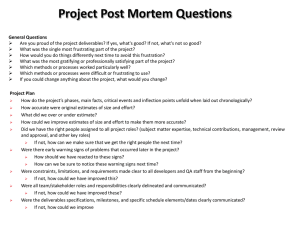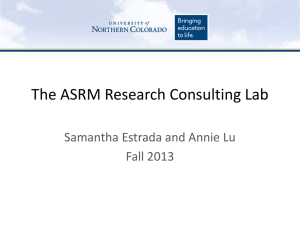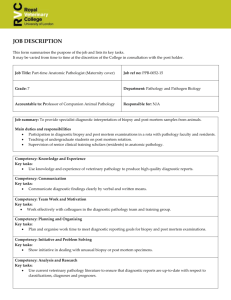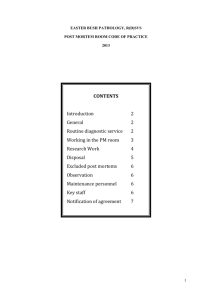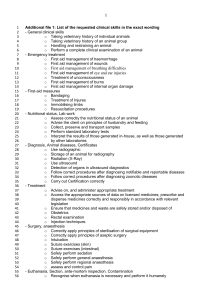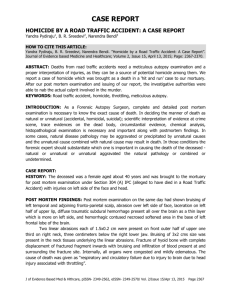Toxicology of a dead animal by Tracey Manning MRCVS
advertisement
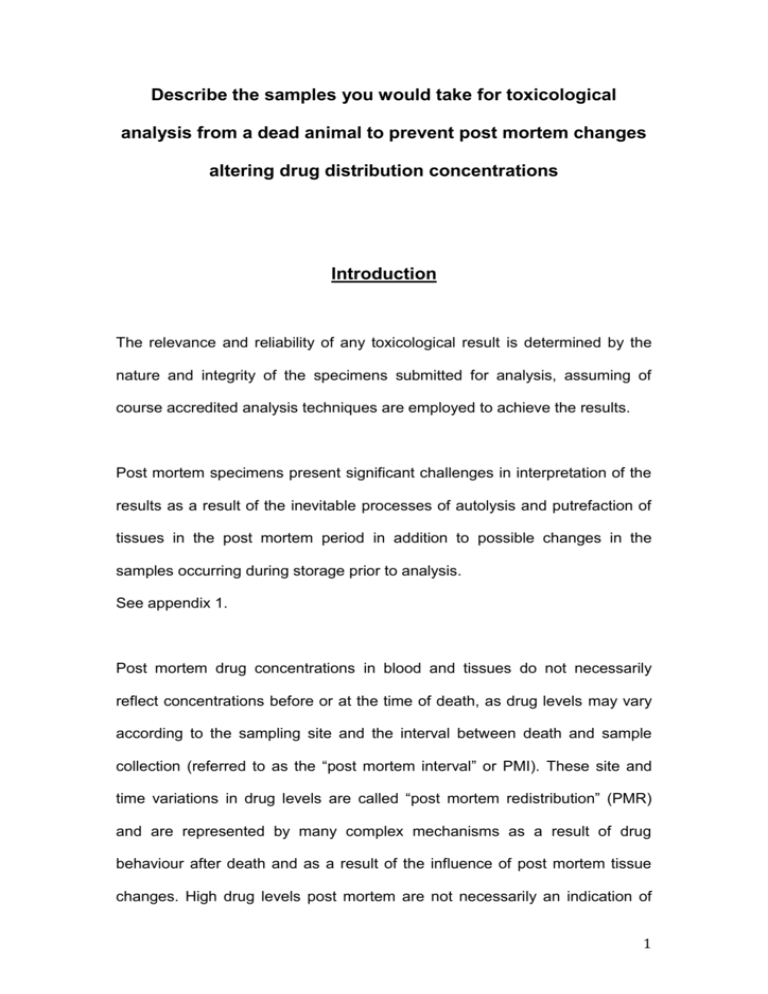
Describe the samples you would take for toxicological analysis from a dead animal to prevent post mortem changes altering drug distribution concentrations Introduction The relevance and reliability of any toxicological result is determined by the nature and integrity of the specimens submitted for analysis, assuming of course accredited analysis techniques are employed to achieve the results. Post mortem specimens present significant challenges in interpretation of the results as a result of the inevitable processes of autolysis and putrefaction of tissues in the post mortem period in addition to possible changes in the samples occurring during storage prior to analysis. See appendix 1. Post mortem drug concentrations in blood and tissues do not necessarily reflect concentrations before or at the time of death, as drug levels may vary according to the sampling site and the interval between death and sample collection (referred to as the “post mortem interval” or PMI). These site and time variations in drug levels are called “post mortem redistribution” (PMR) and are represented by many complex mechanisms as a result of drug behaviour after death and as a result of the influence of post mortem tissue changes. High drug levels post mortem are not necessarily an indication of 1 toxicity or responsible for death and must be interpreted cautiously with the benefit of extensive ongoing research in this field. See appendix 2. It is therefore of paramount importance that a high degree of skill is employed in the correct collection of the most relevant samples at post mortem in order that potential PMR can be detected and taken into account in the interpretation of the results and post collection changes in drug levels are avoided. The key to the successful collection of suitable samples for toxicological analysis is to ensure full prior preparation by familiarity with the history of the case and relevant scene of crime information, to have the appropriate sample containers, labelled correctly, and to observe the recognised stringent requirements for maintenance of the chain of custody of samples. See appendix 3. Legal decisions and the truth about the cause of death rest firstly on the correct retrieval of post mortem specimens. Recommended samples for collection As the science of post mortem toxicological studies has advanced a variety of recognised protocols and recommendations have been suggested for taking 2 samples for toxicological analysis at post mortem examination in humans and animals based on the knowledge we have so far of PMR and the need to carefully consider this when it comes to interpretation. Any specimen of fluid or solid tissue that is or has been in contact with a drug is a potential candidate for toxicological investigation. Peripheral blood Prior to post mortem, 5-10ml should be taken from each of the femoral veins using a large bore hypodermic needle and syringe. Ideally the vessels should be tied off or a tourniquet applied above the point of collection to avoid drawing blood from larger more internal vessels and major organs causing contamination. These samples should be collected into sterile plastic containers and 5ml of it placed in a fluoride/oxalate tube containing 1-2% sodium fluoride as a preservative. This is to avoid the post mortem synthesis of carbon monoxide, the denaturation of the haemoglobin contained in red blood cells, and the inhibition of bacterial ethanol production. Central blood 20-50ml is taken from any large central vessel or from a heart chamber (preferably from the right atrium or inferior vena cava). Blood from this site is only suitable for qualitative (screening) analysis and not for measurement of the level of drugs. The sample should be placed in a sterile plastic container. 3 The proximity of the heart to the lungs and stomach make contamination from these sites by diffusion extremely likely to raise the level of drug in blood from central sites. Urine Preferably urine should be collected prior to the start of post mortem using a syringe and needle through the abdominal wall directly into the bladder. 5-20ml should be placed into one or two sterile plastic containers. If only a small amount is available it should ideally be placed into a glass tube. There is very little correlation between urine and blood concentrations of drugs, however urine has long been considered one of the best fluids for screening for drugs and toxins as a result of its relative lack of protein and fat which interferes with commonly used screening tests. Gastric contents The stomach contents should be collected, by tying off the top and bottom ends of the stomach, and removing this from the body before emptying the entire contents into a sterile container. The total amount of drug or toxin in the stomach contents is far more important than its concentration within the stomach as this will vary according to the overall volume of contents, and cannot be compared to blood concentrations of drugs. Drugs and toxins can enter and leave the stomach after death simply through diffusion. Vitreous humour 4 A narrow gauge needle and a 5ml syringe should be used to collect the vitreous fluid from behind the lens of each eye. It should be placed into sterile plastic containers. Vitreous humour is sterile and therefore not subject to post mortem bacterial action. Vitreous humour lacks the enzymes present in blood, which are responsible for the metabolism and changes occurring in certain drugs. Vitreous humour is also relatively protected from post mortem redistribution and diffusion, as it is relatively remote from the major organs such as liver, stomach, lungs and heart. Do not sample diseased eyes. Although the likelihood of intrinsic ocular disease is small, it should be considered in the interpretation of biochemical and toxicological findings from the vitreous humour. Liver 20 – 100g of tissue is taken from deep within the right lobe, avoiding the gallbladder and not adjacent to the stomach to avoid diffusion contamination. Most drug concentrations are relatively stable in the liver, undergoing relatively little post mortem re-distribution compared to that in blood. Bile The gall bladder should be tied off before removing from the liver. 3 – 10ml should be withdrawn with a sterile syringe and hypodermic needle and placed in a sterile plastic container. Drug concentrations can be significantly higher in bile than in blood. Drugs that undergo recycling between the intestines and the liver can concentrate in 5 bile for a longer period than in blood. As with urine, bile is not in constant equilibrium with circulating blood and therefore cannot be a good predictor of blood drug concentration. Lung 100g should be removed from the apex rather than the base of the right lobe or the whole lobe can be tied off and submitted. It should be stored in a nylon bag and sealed. PMR from the lungs seems to be more intense than redistribution from the intestinal tract. This could be explained by the large surface area of the airways in the lungs and the air sacs (alveoli) and the good blood supply in the lungs. Kidney, Spleen, Brain and Muscle 20 – 100g of tissue should be taken of each. Kidney tissue has classically been used for the measurement of heavy metals. Drug concentrations in the brain should not be affected by PMR or diffusion. However, for some drugs, concentrations may be dependent on the area of the brain the tissue is sampled from. (Ref 14) Spleen can be useful for the measurement of carbon monoxide and cyanide because the organ is rich in red blood cells. Drug analysis on muscle is qualitative rather than quantitative Skeletal muscle can be an ideal forensic specimen as it is present in large quantities and almost always present after putrefaction, trauma and burning. It is less affected by decomposition than blood and internal organs. Sampling is possible away from drug reservoirs such as the liver. Samples are best taken 6 from the lumbar spine region (Iliopsoas muscle). Heart muscle is subject to significant drug redistribution effects and can be useful for qualitative analysis. Cerebrospinal fluid 2-5ml should be collected into a sterile plastic container. As with vitreous humour it contains little protein and fat and therefore drugs tending to bind to proteins and fat will be in lower concentration in these fluids than in blood. Hair 20-100 hairs pulled out or cut at level of skin (if shaved or clipped the cut end must be clearly marked) should be collected and stored in alignment in aluminium foil at room temperature. Hair can be useful in demonstrating exposure to a drug for a long period (weeks to months). Many factors influence drug concentrations in hair, but external contamination from blood, vomit, or putrefactive fluids can lead to elevated drug levels, hence contamination of the collected hair must be avoided. Bone 30g cut into small segments or crushed should be stored in a plastic container with no preservative. It is only useful for qualitative analysis and there are no data to suggest that one anatomic region is better than another. Bone marrow may be useful when other samples are unavailable due to decomposition. It has a good blood supply and a high fat content and may be a reservoir for drugs bound to lipid (fat). 7 Fat 30g should be collected from the layer of fat beneath the abdominal skin into a sterile plastic container with no preservative. It is not frequently analysed due to the difficulty in reliably extracting drugs and because of the substantial variability in parent drug compound/breakdown products between different sites. It can act as a reservoir for drugs strongly bound to lipids. Drugs or toxins identified in post mortem tissues do reflect deposition prior to death and are not a result of PMR, diffusion, or permeation. (Ref 2) Fly larvae (maggots) Up to 10 larvae should be collected if possible and stored in a sterile plastic container with no preservative. These are generally collected only if decomposition prevents the aforementioned more traditional samples from being collected. Drug concentrations will depend on the tissue the larvae had fed on as well as their stage of development. They can only be used for qualitative analysis and drug concentrations in larvae will be significantly lower within 1 day of being removed from the tissue. Faeces 50-100g can be collected into a sterile plastic container. Injection sites Any suspected injection site may be useful in detecting a drug especially if injected into the muscle. However, regardless of the route of administration of the drug, drug may be expected to be found in muscle. The simple detection 8 of a drug at an injection site cannot be used as proof of the route of administration. Conclusion Drugs and toxins can be widely distributed throughout the body. Therefore, almost any biological sample can be used to screen for, identify and measure their presence. It is vital to collect as many relevant samples as possible from the correct sites giving consideration to the history and the presentation and condition of the body. The availability of a comprehensive enough number of relevant samples from the dead animal can be limited due to post mortem decomposition. The measurement (quantification) of a drug is necessary to state whether its amount is sufficient to cause or be directly involved in the death. The interpretation of post mortem results is very different to that in live humans and animals, and largely dependent on the type and quality of samples provided as well as on storage and analytical procedures. The usefulness of analysis in the laboratory of any particular body fluid or tissue will be dictated by the ability to interpret the results according to the condition of the body and the behaviour of the drugs in that particular body following the death of the animal. 9 The levels of drug detected in the post mortem fluids and tissues do not necessarily reflect those immediately prior to death and may therefore not have contributed to the death of the animal. Sampling is the most important step in drug analysis because an analytical result will never be better than the sample from which it was derived. To date, a harmonised protocol for sampling in suspected poisoning or drug related death has not been established. Generally, the specimens routinely collected at post mortem include fluids such as blood from peripheral vessels and the heart, urine, bile, cerebrospinal fluid, vitreous humour, gastric contents, and organs, especially the liver. ArtifactsT Manning in post mortem toxicology are drug concentrations present in body fluids and tissues measured during analysis that do not correspond to the genuine drug level in the body at the time of death. The main collection artifact is contamination, but can be reduced by sampling before the post mortem, if appropriate. It is difficult, if not impossible to acquire useful specimens once the post mortem has been completed. Because of the possible therapeutic history of the animal, the post mortem interval, as well as the collection (avoidance of contamination), storage, processing, and analysis of post mortem samples, these artifacts remain an inherent, intricate and demanding challenge for the toxicologist. The toxicologist uses drug reference concentration databases for different sites to enable comparison. It is essential that a post mortem be carried out using techniques, which recognize the need to avoid and minimise artifactual effects. 10 Appendix 1 Mechanisms of post mortem changes to tissues: 1. Cell death and Autolysis 2. Blood changes 3. Putrefaction Body fluids and tissues are subject to fundamental change during the post mortem period. Decomposition involves the processes of autolysis and putrefaction. Enzymes naturally present in the body induce autolytic changes, whilst putrefaction is caused by destruction by microorganisms. The molecular mechanisms responsible for cell death are complex. A lack of oxygen-carrying capacity starting in the agonal (dying) stage results in reduced available cellular energy. The necessity for anaerobic (without oxygen) generation of energy depletes glycogen reserves rapidly resulting in accumulations of lactic acid reducing cellular pH. Once death has occurred this process progresses rapidly. In addition the failure of the energy dependent sodium pump causes cellular water influx and cell swelling. The combination of acidification and cell swelling results in damage to cell membranes, and leakage of cell contents, including enzymes. Activation of 11 these enzymes leads to digestion of cell components and further damage to membranes. These autolytic processes concern all cells and tissues, but at different rates. It is this disintegration of physiological and anatomical barriers that leads to changes in drug concentrations as drugs leak into the extra-cellular spaces. After death blood sediments and clots unevenly in the body and the cellular component undergoes lysis. The variability of occurrence of clotting and lysis results in a variable ratio of blood cells to serum in respect of drug analysis as drugs are unequally distributed between the cellular components of blood and the fluid (plasma or serum). As permeability of all cell membranes increases, haemolysis (breakdown of red blood cells) occurs. Sedimentation results in blood cells and serum pooling by gravity (hypostasis). Hypostasis causes variations in the percentage of red blood cells by volume dependent on the site in the body. As a result the concentration measured, for any drug exhibiting unequal distribution between red cells and serum, may be biased by irregular clotting, haemolysis and hypostasis. All body fluids other than blood are subject to hypostasis post mortem. Post mortem blood movements within vessels are influenced by pressure and fluid changes as a result of rigor mortis and putrefactive gas distension. This process is responsible for a degree of physical redistribution of drugs between 12 different vascular compartments. For example under the influence of increased abdominal pressure as a result of gas production, blood is pushed from the abdominal aorta to the intra-thoracic aorta. Bacteria present in the gastrointestinal tract at the time of death are known to cross the gastrointestinal wall and enter the blood and lymphatic vessels and continue to migrate throughout tissues subsequently. These bacteria can produce or breakdown compounds within the blood (synthesis, degradation and metabolism) and in extracellular fluid. The best example is ethanol synthesis. In the presence of glucose or other energy substrates and amino acids from protein breakdown, bacteria and yeasts produce ethanol. These putrefactive processes are highly dependent on the ambient conditions, being most prevalent in moist climates, and associated with green discolouration to the body, gas production and bloating, skin slippage and malodour. 13 Appendix 2 There are 3 main mechanisms by which the redistribution of drugs occurs after death: Firstly certain organs, namely the gastro-intestinal tract, liver, lungs and myocardium act as drug reservoirs during life, and after death, these drug reserves are distributed to the surrounding tissues. Secondly, cell and tissue modifications during autolysis and putrefaction affect drug movements. Thirdly the pharmokinetic properties of some drugs can affect concentrations after death. Drug reservoirs 1. Gastro-intestinal tract 2. Lungs 3. Myocardium 4. Liver Cadaveric changes 1. Cell death 2. Blood coagulation and hypostasis (pooling under the influence of gravity) 14 3. Blood movements 4. Putrefactive processes (bacterial action) Drug chemical and pharmacological properties 1. Acid vs alkaline properties 2. Lipophilicity (affinity for fat cells) 3. Drug protein binding or red blood cell binding 4. High volume of distribution 5. Residual metabolic activity after death 15 Appendix 3 All specimen bottles should be clearly labelled with the full name and identification of the animal, date of collection, the type of the specimen and a reference number. When relevant the specific sampling site should be recorded. All specimens must be stored at 4 degrees Centigrade before transport to the laboratory. Each specimen bottle/container should be securely sealed to prevent leakage, and individually packaged in separate plastic bags to prevent cross contamination. Communication with the laboratory for any further requirements is advisable. Specimens must be collected in separate, sterile containers, which should be filled up to minimise evaporation of volatile drugs and losses/reductions of others via contact with air (oxidation). The best materials for collection and storage are glass containers but this can be unreliable when freezing for storage is necessary. However appropriate hard plastic tubes are appropriate for collection of most fluid and tissues for toxicological analysis. Aluminium foil or Teflon lined lids are essential to prevent gas escaping. Solid tissue samples may also be placed in nylon bags, which are tightly sealed. Tubes containing gel separators are not suitable. 16 In addition to the unpreserved samples, fluid samples preserved in 1-5% sodium fluoride tubes are essential. References 1. Butzbach D. The Influence of Putrefaction and Sample Storage on Post-mortem Toxicology Results. Forensic sci med pathol (2010) 6:35-45 2. Dinis-Oliveira R. J, Carvalho F, Duarte J.A, Remiao F, Marques A, Santos A, Magalhaes T. Collection of Biological samples in Forensic Toxicology. Toxicol Mech Methods, 2010 Sept; 20(7): 363-414. 3. Forrest A R W. Obtaining samples at post mortem examination for toxicological and biochemical analyses. April 1993 ACP Broadsheet No 137. 4. Richardson T. Pitfalls in forensic toxicology. Ann Clin Biochem 2000; 37: 20-44. 5. Pelissier-Alicot AL, Gaulier JM, Champsaur P, Marquet P. Mechanisms underlying post-mortem redistribution of drugs: a review. Journal of Analalytical Toxocology, 2003 Nov-Dec; 27(8): 533-44 6. Jones, G.R. 2009. Toxocology: Analysis. Wiley Encyclopaedia of Forensic Science. Published online: 15 September 2009. 7. Guide to obtaining specimens at post mortem for analytical toxicology. http://www.toxlab.co.uk/postmort.htm 8. Butzback, D M. The influence of putrefaction and sample storage on post mortem toxicology results. Forensic Science medical pathology, 2010 Mar; 6(1): 35-45 9. Pounder D J, Jones G R. Post-mortem drug re-distribution – a toxicological nightmare. Forensic Sci Int 1990 April; 45(3): 253-263 10. Cook, D.S, Braithwaite R.A, Hale K.A. Estimating ante mortem drug concentrations from post mortem blood samples – the influence of post mortem redistribution. J Clin path 2000; 53: 282 – 285 17 11. Leikin J B and Watson W A. Post-mortem Toxicology: what the dead can and cannot tell us. Journal of Toxicology 2003; 41(1): 47-56 12. Prouty R.W and Anderson W.H The forensic implications of site and temporal influences on blood drug concentrations. J Forensic Science 1990; 35: 243 13. Parsons M A, Start R D, and Forest A R W. Concurrent Vitreous disease may produce abnormal vitreous humour biochemistry and toxicology. J Clin Path 2003 Sept; 56(9): 720. 14. Spiehler, V.R, Sedgwick, P & Richards, R.G. (1981). The use of brain digoxin concentrations to confirm blood digoxin concentrations. Journal of Forensic Sciences 26, 645-650. 18
